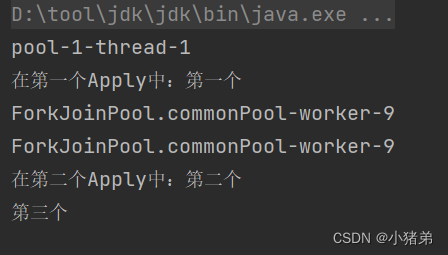其实前面聊future的接口,主要聊的是FurtureTask接口,不过发现其FurtureTask也有其弊端,使用get方法的生活会将线程阻塞。有时候会通过while循环通过isdone来判断是否异步回调已经完成,但是这样虽然会解决阻塞问题,让主线程去执行其它的业务,但是其有一个问题那就是占用CPU的资源。如果不懂可以看另一篇文章:传送阵
除了以上的缺点,还有一个问题,那就是如果处理的了多个异步,然后将所有异步结果进行一起计算呢?如果使用FurtureTask,就有些不方便了。既然我们都可以想到的问题,那么java的大佬岂能不会想到。
所以就有了一个神奇的类CompletableFuture。说句题外话这个类其实操作起来有点像是JavaScript中Promise。如果使用过Promise的话,对于这个CompletableFuture用法就很容易上手。(感兴趣的话可以看我promise的文章:传送阵)

可以看出这个方法是JDK1.8版本才出现的一个新的类,
public class CompletableFuture<T> implements Future<T>, CompletionStage<T>
可以看出CompletableFuture这个类同时实现两个接口Future和CompletionStage。
而可以实现异步调用自然是有Future,而新增的其它功能就是靠另一个接口CompletionStage来实现了。
CompletionStage接口
先看一下官网文档:

这个也是1.8版本才有的一个接口,而简单的说其特点:
-
CompletionStage代表异步计算过程中的某一个阶段,一个阶段完成之后会触发另一个阶段。
-
一个阶段的计算执行可以是一个Function,consumer或者Runnable等,格式和像是是Promise的样子:
例如:
stage.thenApply(x -> square(x)).thenAccept(x -> System.out.print(x)).thenRun(() -> System.out.println())。 另外一个表单( 组合 )应用阶段本身的功能,而不是它们的结果。 -
一个阶段的执行可能是被单个阶段完成触发,也可以由多个阶段一起触发。
现在不看源码,简单的说就是简单演示其如何使用,以及使用的需要注意的事情。其有很多方法:

这些都是抽象方法,很多方法都需要实现其接口的子类来是使用,所以还是通过CompletableFuture来实现这些方法。
CompletableFuture
主要聊这个这个类,其也是java1.8版本之后新增的一个类,其提供了非常强大的Future的扩展功能。
- 可以帮助程序员使用异步的时候简化,并且提供了函数式编程的能力,可以通过回调方法得到处理结果,也提供了转换和组合CompletableFuture的方法。
- 可以实现完成的Future,也可以代表一个完成阶段的CompletionStage,它支持在计算完成以后触发一些函数或执行某些动作。毕竟实现了Future和CompletionStage两个接口。
现在开始用代码演示吧。毕竟直说理论都懵,而且也不太擅长。
创建一个CompletableFuture
CompletableFuture类可以通过new进行创建。
看一下官网的说法:
CompletableFuture()
创建一个新的不完整的CompletableFuture。
这个这个构建方法,简单的说就是为了满足java中的对象类可以通过new可以创建一个实例对象,同时也为了方便以后的修改而保留了这个new创建实例对象的能力。但是官网有给出了一个建议,那就是这个一个不完整的CompletableFuture。
那如何创建创建一个CompletableFuture类呢?看官网API的时候看出CompletableFuture有很多方法可以得到CompletableFuture类。

所以可以看出需要通过方法返回CompletableFuture这个类,而一般使用对是通过静态方法返回
四大核心静态方法

虽然有七个,但是最核心或者说常用的四个:
| 静态方法 | 描述 | 补充 |
|---|---|---|
runAsync(Runnable runnable) | 返回一个新的CompletableFuture,它在运行给定操作后由运行在 ForkJoinPool.commonPool()中的任务 异步完成。 | 无返回值 |
runAsync(Runnable runnable, Executor executor) | 返回一个新的CompletableFuture,它在运行给定操作之后由在给定执行程序中运行的任务异步完成。 | 无返回值 |
supplyAsync(Supplier<U> supplier) | 返回一个新的CompletableFuture,它通过在 ForkJoinPool.commonPool()中运行的任务与通过调用给定的供应商获得的值 异步完成。 | 有返回值 |
supplyAsync(Supplier<U> supplier, Executor executor) | 返回一个新的CompletableFuture,由给定执行器中运行的任务异步完成,并通过调用给定的供应商获得的值。 | 有返回值 |
补充:
- 其中Supplier是也是新增的四大核心函数式接口,如果不了解可以看下传送阵
- 如果没有指定Executor的方法,直接使用默认的ForkJoinPool.commonPool()作为它的线程池执行异步代码的,如果指定了线程池,则使用自定义或者特别指定线程池执行的异步代码。
还是老规矩,开始代码演示:
- 没有返回值:
public class test {
public static void main(String[] args) throws ExecutionException, InterruptedException {
CompletableFuture<Void> completableFuture=CompletableFuture.runAsync(()->{
System.out.println("Runnable生成的线程"+Thread.currentThread().getName());
try {
TimeUnit.SECONDS.sleep(2);
} catch (InterruptedException e) {
throw new RuntimeException(e);
}
});
System.out.println(completableFuture.get());
}
}

通过线程的名字可以看出ForkJoinPool.commonPool,可以看出其默认的线程池生成的。
现在来创建一个自定义的Executor类,试一下:
public class test {
public static void main(String[] args) throws ExecutionException, InterruptedException {
// 为了演示,直接使用工具类中返回的线程池,而不通过new ThreadPoolExecutor();创建线程池了
Executor executor= Executors.newFixedThreadPool(3);
CompletableFuture<Void> completableFuture=CompletableFuture.runAsync(()->{
System.out.println("Runnable生成的线程"+Thread.currentThread().getName());
try {
TimeUnit.SECONDS.sleep(2);
} catch (InterruptedException e) {
throw new RuntimeException(e);
}
},executor);
System.out.println(completableFuture.get());
executor.shutdown();
}
}

-
有返回值:
因为默认线程池和自定义线程池大多数都雷同,为了减少篇幅所以直接写。
public class test { public static void main(String[] args) throws ExecutionException, InterruptedException { // 为了演示,直接使用工具类中返回的线程池,而不通过new ThreadPoolExecutor();创建线程池了 ExecutorService executor = Executors.newFixedThreadPool(3); CompletableFuture<String> completableFuture = CompletableFuture.supplyAsync(() -> { System.out.println("Runnable生成的线程" + Thread.currentThread().getName()); try { TimeUnit.SECONDS.sleep(2); } catch (InterruptedException e) { throw new RuntimeException(e); } return "有返回值了"; }, executor); System.out.println(completableFuture.get()); executor.shutdown(); } }

CompletableFuture优势
前面一直说Future的接口(前面用FurtureTask演示的)说到其会造成阻塞或者解决方式会消耗CPU性能。而CompletableFuture自然就是为了解决这个问题:CompletableFuture是Future的功能增强版,减少阻塞和轮询。可以传入回调对象,当异步任务完成或者发生异常的时候,会自动调用回调对象的回调方法。
既然要是加强版,自然也会有其原来就有的能力。
来一个原理有的能力演示:
public class test {
public static void main(String[] args) throws ExecutionException, InterruptedException {
// 为了演示,直接使用工具类中返回的线程池,而不通过new ThreadPoolExecutor();创建线程池了
ExecutorService executor = Executors.newFixedThreadPool(3);
CompletableFuture<String> completableFuture = CompletableFuture.supplyAsync(() -> {
System.out.println("Runnable生成的线程" + Thread.currentThread().getName());
try {
TimeUnit.SECONDS.sleep(2);
} catch (InterruptedException e) {
throw new RuntimeException(e);
}
return "有返回值了";
}, executor);
System.out.println("运行主线程");
System.out.println(completableFuture.get());
System.out.println("运行完毕");
executor.shutdown();
}
}

如果这样写,运动的话,可以看出其,还是有阻塞这个弊端的。
不过仔细看方法的话,还有一个join方法:
get和join区别
CompletableFuture中多了一个方法join,但是看起使用的时候似乎与get方法一样,如果说效果的话,两者没有什么区别,都是返回异步任务的返回值,但是既然说其有区别,自然就有区别。
通过编译软件可以看出:



可以看出其两者最大的区别,就是在编译的时候是否抛出异常,当然如果允许中出现异常join也会抛出的。
再聊Future的时候来一个对比有戏价格的例子,现在用CompletableFuture体验一下:
public class test {
public static void main(String[] args) throws InterruptedException {
List<NetShop> shoplist = Arrays.asList(
new NetShop("拼多多"),
new NetShop("京东"),
new NetShop("淘宝")
);
long start = System.currentTimeMillis();
List<String> pricelist=shoplist.stream().map((shop) ->
CompletableFuture.supplyAsync(() ->
String.format("塞尔达在" + "在%s中的价格是%s", shop.getName(), shop.getPrice())
)
).collect(Collectors.toList()).stream().map(cp->cp.join()).collect(Collectors.toList());
pricelist.forEach(price->{
System.out.println(price);;
});
long end = System.currentTimeMillis();
System.out.println("运行的时间:"+(end -start));
}
}
class NetShop {
String name;
public NetShop(String name) {
this.name = name;
}
public String getName() {
return name;
}
public void setName(String name) {
this.name = name;
}
// 直接通过方法得到一个随机价格,而不在写价格属性了
public Double getPrice() {
Double price = 0d;
try {
TimeUnit.SECONDS.sleep(1);
price = ThreadLocalRandom.current().nextDouble() + 299;
} catch (Exception E) {
E.printStackTrace();
} finally {
return price;
}
}
}

这里体验的时候一定要注意:
//异步没有生效不知道为什么,这个可能需要再研究一下
map().map()
// 异步生效了
map().collect(Collectors.toList().map()
说实话这个疑问,我目前还没有找到原因。如果找到了以后再补充吧,这里还是提醒。
而且前面一直说有点像是JavaScript中的Promise所以自然应该有类似的调用。
因为有很多方法,暂时不说所有的想法,这个时候为了演示CompletableFuture的优势,所以先通过几个方法演示优势,后面具体聊所有的方法。

还是老规矩代码演示:
public class test {
public static void main(String[] args) throws ExecutionException, InterruptedException {
// 为了演示,直接使用工具类中返回的线程池,而不通过new ThreadPoolExecutor();创建线程池了
ExecutorService executor = Executors.newFixedThreadPool(3);
CompletableFuture<String> completableFuture = CompletableFuture.supplyAsync(() -> {
System.out.println("Runnable生成的线程" + Thread.currentThread().getName());
try {
TimeUnit.SECONDS.sleep(2);
} catch (InterruptedException e) {
throw new RuntimeException(e);
}
return "有返回值了";
}, executor);
System.out.println("运行主线程");
// 这里的两个参数,第一个v是completableFuture的返回值,第二个e是异常或者报错信息
completableFuture.whenComplete((v,e)->{
if(e==null){
System.out.println("有get的效果得到值:"+v);
}
});
System.out.println("运行完毕");
executor.shutdown();
}
}
现在看一下运行效果:

可以看出其没有阻塞主线程的运行,而是异步返回结果在返回的时候得到了。
然后再来一个有异常的:
public class test {
public static void main(String[] args) throws ExecutionException, InterruptedException {
// 为了演示,直接使用工具类中返回的线程池,而不通过new ThreadPoolExecutor();创建线程池了
ExecutorService executor = Executors.newFixedThreadPool(3);
CompletableFuture<String> completableFuture = CompletableFuture.supplyAsync(() -> {
System.out.println("Runnable生成的线程" + Thread.currentThread().getName());
try {
TimeUnit.SECONDS.sleep(2);
} catch (InterruptedException e) {
throw new RuntimeException(e);
}
double a= 1/0;
return "有返回值了";
}, executor);
System.out.println("运行主线程");
// 这里的两个参数,第一个v是completableFuture的返回值,第二个e是异常或者报错信息
completableFuture.whenComplete((v,e)->{
if(e==null){
System.out.println("有get的效果得到值:"+v);
}else {
System.out.println(e);
}
});
System.out.println("运行完毕");
executor.shutdown();
}
}

其实调用whenComplete方法可以返回得到一个completableFuture,那么连续用呢?
public class test {
public static void main(String[] args) throws ExecutionException, InterruptedException {
// 为了演示,直接使用工具类中返回的线程池,而不通过new ThreadPoolExecutor();创建线程池了
ExecutorService executor = Executors.newFixedThreadPool(3);
CompletableFuture<String> completableFuture = CompletableFuture.supplyAsync(() -> {
System.out.println("Runnable生成的线程" + Thread.currentThread().getName());
try {
TimeUnit.SECONDS.sleep(2);
} catch (InterruptedException e) {
throw new RuntimeException(e);
}
return "有返回值了";
}, executor);
System.out.println("运行主线程");
// 这里的两个参数,第一个v是completableFuture的返回值,第二个e是异常或者报错信息
completableFuture.whenComplete((v,e)->{
if(e==null){
System.out.println("有get的效果得到值:"+v);
v=v+" 这里可以修改v,同时将v这个值再次返回";
}
}).whenComplete((v,e)->{
System.out.println("第二次 有get的效果得到值:"+v);
});
System.out.println("运行完毕");
executor.shutdown();
}
}

可以看出这个后面第二个的参数v的值,和第一参数v的值似乎是一个值,而且在第一个whenComplete方法中似乎对v值的修改没有传递到后面的whenComplete方法中。
不过能否称为连续调用呢?自然可以当然不是这种方法。下面开始聊CompletableFuture的方法,其方法太多了,毕竟是强化版。
方法
其方法很多,还是那句话,本篇只能聊如何用,而不是去翻看源码的实现。
获取结果
这一类方法,都是获取异步的运算的结果;
| 方法 | 描述 |
|---|---|
| public T get() | 等待这个未来完成的必要,然后返回结果。 |
| public T get(long timeout, TimeUnit unit) | 如果有必要等待这个未来完成的给定时间,然后返回其结果(如果有的话)。 |
| public T join() | 完成后返回结果值,如果完成异常,则返回(未检查)异常。 |
| public T getNow(T valueIfAbsent) | 如果已完成,则返回结果值(或抛出任何遇到的异常),否则返回给定的值IfAbsent。 |
| public boolean complete(T value) | complete方法可以判断异步是否执行完毕,如果执行完毕返回False,然后参数代替返回值。如果未执行完毕则返回ture,然后参数代替返回值。 |
这个可以前三个方法就不再具体说了,毕竟前面一直使用,现在简单的演示一下表中的第四个方法。
public class test {
public static void main(String[] args) {
CompletableFuture completableFuture1 = CompletableFuture.supplyAsync(() -> {
int a = 1 / 0;
return 10;
});
CompletableFuture completableFuture2 = CompletableFuture.supplyAsync(() -> {
return 10;
});
System.out.println(" 错误运算后的返回值:"+completableFuture1.getNow(4));
System.out.println(" 正确后的返回值:"+completableFuture2.getNow(4));
}
}

其实这个方法,还有一个特点,那就是不会阻塞,因为如果没有返回值可以得到参数值,所以不会阻塞。
现象演示一下complete方法。
public class test {
public static void main(String[] args) {
CompletableFuture completableFuture1 = CompletableFuture.supplyAsync(() -> {
try {
Thread.sleep(200);
} catch (InterruptedException e) {
throw new RuntimeException(e);
}
return 10;
});
CompletableFuture completableFuture2 = CompletableFuture.supplyAsync(() -> {
return 10;
});
System.out.println(" 错误运算后的返回值:"+completableFuture1.complete(4)+ " "+completableFuture1.join());
System.out.println(" 正确后的返回值:"+completableFuture2.complete(4)+" "+completableFuture1.join());
}
}

可以看出complete方法可以判断异步是否执行完毕,如果执行完毕返回False,然后参数代替返回值。如果未执行完毕则返回ture,然后参数代替返回值。
处理计算结果
| 方法 | 描述 |
|---|---|
public CompletableFuture thenApply(Function<? super T,? extends U> fn) | 返回一个新的CompletionStage,当此阶段正常完成时,将以该阶段的结果作为所提供函数的参数执行 |
public CompletableFuture handle(BiFunction<? super T,Throwable,? extends U> fn) | 返回一个新的CompletionStage,当此阶段正常或异常完成时,将使用此阶段的结果和异常作为所提供函数的参数执行。 当完成作为参数时,使用结果(或null如果没有))和此阶段的异常(或null如果没有))调用给定函数。 |
现在开始演示,前面一直说CompletableFuture可以将异步串联起来,所以现在试一下:
public class test {
public static void main(String[] args) {
CompletableFuture completableFuture1 = CompletableFuture.supplyAsync(() -> {
try {
Thread.sleep(200);
} catch (InterruptedException e) {
throw new RuntimeException(e);
}
return "第一个";
});
completableFuture1.thenApply((v)->{
System.out.println("在第一个Apply中:"+v);
return "第二个";
}).thenApply((v)->{
System.out.println("在第二个Apply中:"+v);
return "第三个";
}).whenComplete((v,e)->{
if(e==null){
System.out.println("在when中:"+v);
}
});
System.out.println("运行主线程");
}
}

似乎没有效果啊,因为CompletableFuture是为了解决阻塞的,所以会自动关闭的。所以前面演示的时候才会使用自己创建的线程池。
现在真正演示:
public class test {
public static void main(String[] args) {
ExecutorService executorService=Executors.newFixedThreadPool(3);
CompletableFuture completableFuture1 = CompletableFuture.supplyAsync(() -> {
try {
Thread.sleep(200);
} catch (InterruptedException e) {
throw new RuntimeException(e);
}
return "第一个";
},executorService);
completableFuture1.thenApply((v)->{
System.out.println("在第一个Apply中:"+v);
return "第二个";
}).thenApply((v)->{
System.out.println("在第二个Apply中:"+v);
return "第三个";
}).whenComplete((v,e)->{
if(e==null){
System.out.println("在when中:"+v);
}
});
System.out.println("运行主线程");
executorService.shutdown();
}
}

可以看出现在可以将异步作为一个串行来处理了。
现在再来一个实验那就是如果中级报错:
public class test {
public static void main(String[] args) {
ExecutorService executorService=Executors.newFixedThreadPool(3);
CompletableFuture completableFuture1 = CompletableFuture.supplyAsync(() -> {
try {
Thread.sleep(200);
} catch (InterruptedException e) {
throw new RuntimeException(e);
}
return "第一个";
},executorService);
completableFuture1.thenApply((v)->{
System.out.println("在第一个Apply中:"+v);
int a=1/0;
return "第二个";
}).thenApply((v)->{
System.out.println("在第二个Apply中:"+v);
return "第三个";
}).whenComplete((v,e)->{
if(e==null){
System.out.println("在when中:"+v);
}
}).exceptionally(e->{
// 这个可以获得异常的数据
System.out.println("捕获异常----"+e);
return null;
});
System.out.println("运行主线程");
executorService.shutdown();
}
}

可以看出如果thenApply中出现错误,就会将串行截断,而这个时候就需要使用handle方法。
演示:
public class test {
public static void main(String[] args) {
ExecutorService executorService=Executors.newFixedThreadPool(3);
CompletableFuture completableFuture1 = CompletableFuture.supplyAsync(() -> {
try {
Thread.sleep(200);
} catch (InterruptedException e) {
throw new RuntimeException(e);
}
return "第一个";
},executorService);
completableFuture1.handle((f,v)->{
System.out.println("在第一个handle中:"+v);
int a=1/0;
return "第二个";
}).handle((f,v)->{
System.out.println("在第二个handle中:"+v);
return "第三个";
}).whenComplete((v,e)->{
if(e==null){
System.out.println("在when中:"+v);
}
}).exceptionally(e->{
// 这个可以获得异常的数据
System.out.println("捕获异常----"+e);
return null;
});
System.out.println("运行主线程");
executorService.shutdown();
}
}

消费计算结果
| 方法 | 描述 |
|---|---|
public CompletableFuture thenAccept(Consumer<? super T> action) | 返回一个新的CompletionStage,当此阶段正常完成时,将以该阶段的结果作为提供的操作的参数执行 |
看参数就指定,这是一个消费者这接口所以可以说这个没有返回值。所以老规矩还是直接演示代码吧:
public class test {
public static void main(String[] args) {
ExecutorService executorService = Executors.newFixedThreadPool(3);
CompletableFuture completableFuture1 = CompletableFuture.supplyAsync(() -> {
try {
Thread.sleep(200);
} catch (InterruptedException e) {
throw new RuntimeException(e);
}
return "第一个";
}, executorService);
completableFuture1.thenApply((v) -> {
System.out.println("thenApply----:" + v);
return "第二个";
}).thenAccept((v) -> {
// 其没有返回值所以无需返回值 这个也可以看出其与thenApply的区别了
System.out.println("thenAccept----:" + v);
});
System.out.println("运行主线程");
executorService.shutdown();
}
}

这个可以看出了threnApply和thenAccept两个方法的区别了,既然说区别,就再补充一个方法吧,那就是很相似的一个方法thenRun.
| 方法 | 描述 |
|---|---|
public CompletableFuture thenRun(Runnable action) | 返回一个新的CompletionStage,当此阶段正常完成时,执行给定的操作.不过可以看出其异步中也不会返回数据。 |
不过其实际就是重写开启了一个线程。而这个线程与上一个线程没有任何关系。
public class test {
public static void main(String[] args) {
ExecutorService executorService = Executors.newFixedThreadPool(3);
CompletableFuture completableFuture1 = CompletableFuture.supplyAsync(() -> {
try {
Thread.sleep(200);
System.out.println("completableFuture1-------");
} catch (InterruptedException e) {
throw new RuntimeException(e);
}
return "第一个";
}, executorService);
completableFuture1.thenRun(()->{
System.out.println("thenRun-------");
});
System.out.println("运行主线程");
executorService.shutdown();
}
}

运算速度选用
| 方法 | 描述 |
|---|---|
public CompletableFuture applyToEither(CompletionStage<? extends T> other,Function<? super T,U> fn) | 返回一个新的CompletionStage,当这个或另一个给定阶段正常完成时,执行相应的结果作为提供的函数的参数。 |
其实这个看的有点懵,还是代码演示:
public class test {
public static void main(String[] args) {
ExecutorService executorService = Executors.newFixedThreadPool(3);
CompletableFuture completableFuture1 = CompletableFuture.supplyAsync(() -> {
try {
Thread.sleep(200);
System.out.println("completableFuture1-------");
} catch (InterruptedException e) {
throw new RuntimeException(e);
}
return "completableFuture1";
}, executorService);
CompletableFuture completableFuture2 = CompletableFuture.supplyAsync(() -> {
try {
Thread.sleep(100);
System.out.println("completableFuture2-------");
} catch (InterruptedException e) {
throw new RuntimeException(e);
}
return "completableFuture2";
}, executorService);
completableFuture1.acceptEither(completableFuture2,(v)->{
System.out.println("acceptEither调用运行时间短的-------"+v);
});
System.out.println("运行主线程");
executorService.shutdown();
}
}

可以看出completableFuture1设置的睡眠时间长,所以acceptEither选择运行了completableFuture2的结果。所以可以看出调用的completableFuture对比一些参数第一个completableFuture。两者谁运行的快然后用谁的运行结果。
运算结果合并
| 方法 | 描述 |
|---|---|
public <U,V> CompletableFuture thenCombine(CompletionStage<? extends U> other,BiFunction<? super T,? super U,? extends V> fn) | 返回一个新的CompletionStage,当这个和另一个给定的阶段都正常完成时,两个结果作为提供函数的参数执行。 |
这个其实是将两个异步任务的结果一起交给thenCombine进行处理,先完成的等待,等待其它的分支,然后再一起合并处理。
public class test {
public static void main(String[] args) {
ExecutorService executorService = Executors.newFixedThreadPool(3);
CompletableFuture completableFuture1 = CompletableFuture.supplyAsync(() -> {
try {
Thread.sleep(200);
System.out.println("completableFuture1-------");
} catch (InterruptedException e) {
throw new RuntimeException(e);
}
return "completableFuture1";
}, executorService);
CompletableFuture completableFuture2 = CompletableFuture.supplyAsync(() -> {
try {
Thread.sleep(300);
System.out.println("completableFuture2-------");
} catch (InterruptedException e) {
throw new RuntimeException(e);
}
return "completableFuture2";
}, executorService);
completableFuture1.thenCombine(completableFuture2,(v1,v2)->{
String cb="合并两个结果-------"+v1+" "+v2;
return cb;
}).thenAccept((v)->{
System.out.println(v);
});
System.out.println("运行主线程");
executorService.shutdown();
}
}

前面的确说一些方法,但是与官网的API还是差太多了,现在看一下有多少方法;



前面虽然聊了不少方法,如果一对比似乎等于说了九头牛中的一根毛,但是仔细观看的的会发现很多方法,似乎多了个Async。现在举一个例子,比如thenApply和thenApplyAsync。这两者有什么区别吗?下面说。
补充-线程池选择
其实如果查询Async翻译的话 :

这个时候就有点懵了,completableFuture本身不是异步任务吗?咋地又来一个异步?
这个如何理解呢,还是老规矩代码演示:
public class test {
public static void main(String[] args) {
CompletableFuture completableFuture1 = CompletableFuture.supplyAsync(() -> {
try {
Thread.sleep(200);
} catch (InterruptedException e) {
throw new RuntimeException(e);
}
System.out.println(Thread.currentThread().getName());
return "第一个";
}).thenApply((v)->{
try {
Thread.sleep(200);
} catch (InterruptedException e) {
throw new RuntimeException(e);
}
System.out.println("在第一个Apply中:"+v);
System.out.println(Thread.currentThread().getName());
return "第二个";
}).thenApply((v)->{
try {
Thread.sleep(200);
} catch (InterruptedException e) {
throw new RuntimeException(e);
}
System.out.println(Thread.currentThread().getName());
System.out.println("在第二个Apply中:"+v);
return "第三个";
}) ;
System.out.println(completableFuture1.join());
}
}

其实这个打印出的 线程池的来源,这个前面也演示过,这里不过是再演示一下而已。
public class test {
public static void main(String[] args) {
ExecutorService executorService=Executors.newFixedThreadPool(3);
CompletableFuture completableFuture1 = CompletableFuture.supplyAsync(() -> {
System.out.println(Thread.currentThread().getName());
return "第一个";
},executorService).thenApply((v)->{
try {
Thread.sleep(200);
} catch (InterruptedException e) {
throw new RuntimeException(e);
}
System.out.println("在第一个Apply中:"+v);
System.out.println(Thread.currentThread().getName());
return "第二个";
}).thenApply((v)->{
try {
Thread.sleep(200);
} catch (InterruptedException e) {
throw new RuntimeException(e);
}
System.out.println(Thread.currentThread().getName());
System.out.println("在第二个Apply中:"+v);
return "第三个";
}) ;
// 阻塞一下,不然没有效果
System.out.println(completableFuture1.join());
executorService.shutdown();
}
}

上面两个方法,有点重复,但是又不得不列出,现在再将thenApply编程thenApplyAsync。
public class test {
public static void main(String[] args) {
ExecutorService executorService=Executors.newFixedThreadPool(3);
CompletableFuture completableFuture1 = CompletableFuture.supplyAsync(() -> {
System.out.println(Thread.currentThread().getName());
return "第一个";
},executorService).thenApplyAsync((v)->{
try {
Thread.sleep(200);
} catch (InterruptedException e) {
throw new RuntimeException(e);
}
System.out.println("在第一个Apply中:"+v);
System.out.println(Thread.currentThread().getName());
return "第二个";
}).thenApplyAsync((v)->{
try {
Thread.sleep(200);
} catch (InterruptedException e) {
throw new RuntimeException(e);
}
System.out.println(Thread.currentThread().getName());
System.out.println("在第二个Apply中:"+v);
return "第三个";
}) ;
// 阻塞一下,不然没有效果
System.out.println(completableFuture1.join());
executorService.shutdown();
}
}

可以看出带上Async,其后面调用的异步方式的线程池变了。
由此可以总结:
- 如果不传递自定义线程池,都是默认的ForkJoinPool。
- 如果执行的第一个任务的时候传递了一个自定义的线程池,现在可以看出有两种个情况。
- 如果执行的的不带有Async执行第二个任务时,则第二个任务和第一个任务共用一个自定义线程池。
- 如果带有Async执行第二个任务时,则第一个任务使用自定义线程池,但是如果带有Async那就是使用的是ForkJoin线程池,而其后面是否带有Async都是ForkJoin线程池了。
不过又要补充一点,未来防止出现问题,我使用线程休眠,如果取消掉呢?
public class test {
public static void main(String[] args) {
ExecutorService executorService=Executors.newFixedThreadPool(3);
CompletableFuture completableFuture1 = CompletableFuture.supplyAsync(() -> {
System.out.println(Thread.currentThread().getName());
return "第一个";
},executorService).thenApply((v)->{
System.out.println("在第一个Apply中:"+v);
System.out.println(Thread.currentThread().getName());
return "第二个";
}).thenApply((v)->{
System.out.println(Thread.currentThread().getName());
System.out.println("在第二个Apply中:"+v);
return "第三个";
}) ;
// 阻塞一下,不然没有效果
System.out.println(completableFuture1.join());
executorService.shutdown();
}
}

可以看出:
因为处理的时间很多,系统优化的切换的原则,使用是不带有Async,但是线程也直接用main线程处理了。
再用带有Async的试一下:
public class test {
public static void main(String[] args) {
ExecutorService executorService=Executors.newFixedThreadPool(3);
CompletableFuture completableFuture1 = CompletableFuture.supplyAsync(() -> {
System.out.println(Thread.currentThread().getName());
return "第一个";
},executorService).thenApplyAsync((v)->{
System.out.println("在第一个Apply中:"+v);
System.out.println(Thread.currentThread().getName());
return "第二个";
}).thenApplyAsync((v)->{
System.out.println(Thread.currentThread().getName());
System.out.println("在第二个Apply中:"+v);
return "第三个";
}) ;
// 阻塞一下,不然没有效果
System.out.println(completableFuture1.join());
executorService.shutdown();
}
}

可以看出这样调用的不会使用main线程,这个就需要看一下源码,来查看问什么?
看一下:
public <U> CompletableFuture<U> thenApplyAsync(
Function<? super T,? extends U> fn) {
return uniApplyStage(asyncPool, fn);
}
可以看出这个是有一个线程池参数asyncPool,既然这里可以放,那就是数一个类属性或者属性所以直接搜索然后看:
private static final boolean useCommonPool =
(ForkJoinPool.getCommonPoolParallelism() > 1);
/**
* Default executor -- ForkJoinPool.commonPool() unless it cannot
* support parallelism.
*/
// 三目运算符因为useCommonPool上面已经定义,所以使用了ForkJoinPool
private static final Executor asyncPool = useCommonPool ?
ForkJoinPool.commonPool() : new ThreadPerTaskExecutor();
/** Fallback if ForkJoinPool.commonPool() cannot support parallelism */
static final class ThreadPerTaskExecutor implements Executor {
public void execute(Runnable r) { new Thread(r).start(); }
}
既然调用ForkJoinPool线程池,那么ForkJoinPool自然尤其优势,这个后面具体聊,篇幅够长了。





















 532
532











 被折叠的 条评论
为什么被折叠?
被折叠的 条评论
为什么被折叠?








